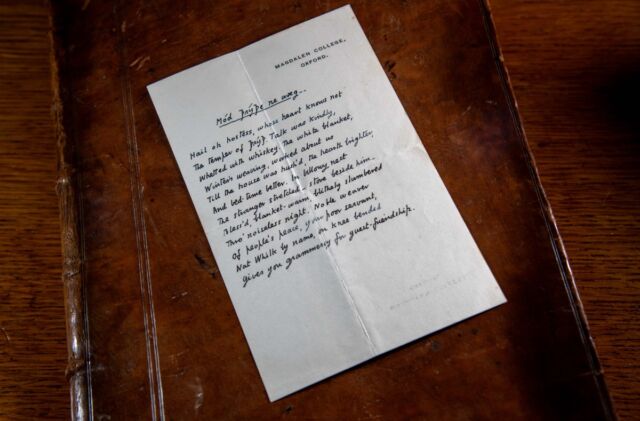
© CS Lewis Pte Ltd
Renowned British author C.S. Lewis is best known for his Chronicles of Narnia, but Lewis’s prolific oeuvre also included a science fiction trilogy, an allegorical novel, a marvelous retelling of the myth of Cupid and Psyche, various nonfiction works of Christian apologetics, and literary criticism. Now, a literary scholar has discovered a previously unknown short poem by Lewis among a cache of documents acquired by the University of Leeds ten years ago. Written in 1935, the poem has been published for the first time, with an accompanying analysis in the Journal of Inkling Studies.
The journal’s title refers to the so-called “Oxford Inklings,” a group of Oxford-based scholars and writers who met regularly to read each others’ works aloud, most often at an Oxford pub called The Eagle and Child (aka the Bird and the Baby). In addition to Lewis, the group included J.R.R. Tolkien and Charles Williams. (All three were the main characters of James A. Owens’ fantasy series, The Chronicles of the Imaginarium Geographica.) I once called the Inklings “arguably the literary mythmakers” of their generation.
Lewis and Tolkien in particular shared a love of Norse mythology, and Lewis read the first early drafts of what would become Tolkien’s Lord of the Rings trilogy. Tolkien later said he owed his friend “an unpayable debt” for convincing him the “stuff” could be more than merely a “private hobby.” Tolkien, in turn, was the one who convinced Lewis—an atheist in his youth—to convert to Christianity.
General readers are likely less familiar with Lewis as a medieval scholar specializing in the late Middle Ages. His fiction works are rife with symbolism and dominant themes from that literary epoch. But he was also a fan of the epic Anglo-Saxon masterpiece Beowulf, which he initially read in translation (like almost everyone else). By the time he began teaching at Oxford’s Magdalen College, he had become sufficiently proficient with Old English to host occasional “Beer and Beowulf” sessions at the college, according to Andoni Cossio, a scholar at the University of Basque and the University of Glasgow.

© CS Lewis Pte Ltd
It was Cossio who found the Lewis poem while browsing through the Leeds Tolkien-Gordon Collection, which includes a first edition of The Hobbit and an Old English bridal song Tolkien wrote for Eric Valentine (E.V.) and Ida Gordon, a scholarly Oxford couple who were close friends of Tolkien’s.
It seems they were also acquainted with Lewis, since the newly discovered poem, titled “Mód Þrýþe Ne Wæg,” appears to have been written in thanks after Lewis stayed with them at their Manchester home. The manuscript has an accompanying Post-It note by the document’s previous owner reading, “Another unusual thank your from C.S. Lewis.” (The note originally read “from J.R.R.T., but those initials were crossed out.) The text particularly praises the whisky, white blankets, and warmth Lewis experienced during his stay.
“The moment I first read the manuscript, I was enraptured by its content. It had everything I could wish for: biographical details, Old English, alliterative meter, and Lewis’s writing at its best,” said Cossio. “The thing I like most about this poem is that it opens a little door to that world. It was soon obvious that it had passed completely unnoticed since its private owner transferred it to the University of Leeds in 2014. To discover the poem’s secrets, I would have to do the research myself.”
And so he did, starting with verifying the date of the undated poem; no envelope survived. There is no mention of a friendship with the Gordons in any of Lewis’s published biographies or correspondence, so Cossio concluded the connection was through a common friend, i.e., Tolkien. Sometime in 1932–1933, both Lewis and Tolkien were serving as examiners in Oxford’s English school along with E.V. Gordon, a professor of English language. Tolkien himself wrote a short epistolary poem dated June 26, 1935 thanking the Gordons for their hospitality when he stayed at their home, and that poem references an earlier stay by Lewis. Specifically, Tolkien wrote that he hoped Lewis’s thank-you verse had reached them, indicating that both poems were written in 1935.
This was also the same year that Lewis published “a theoretical essay on adapting Old English alliterative lines to modern English versification,” per Cossio. The new poem adopts a similar alliterative meter, and its title (and pseudonymous pen name, “Nat Whilk”) are playful Beowulf/Old English references, most likely for the benefit of Ida Gordon, who held a PhD in philology (the history of language). “Nat Whilk” is an indefinite pronoun roughly translating as an unknown person, or “anonymous,” per Cossio.
“Mód Þrýþe Ne Wæg” is more difficult to translate. It’s a reference to a specific line (1931b) in Beowulf, but scholars have different opinions as to how this should be interpreted. Some think it is a proper name “whose meaning is distilled from the sum of its elements”; others disagree, including Tolkien in his own translation of Beowulf, according to Cossio. Cossio’s reasoning rests on the use of the proper name in the Lewis poem’s second line, describing his hostess as one whose “heart knows not/The temper of Þrýþ.”
“Since Þrýþ was wicked and her mood was fierce, according to Tolkien’s interpretation and translation that Lewis seems to agree with, the negative phrase in the title of the poem can only be read as a compliment to Ida Gordon,” Cossio wrote. Taken together with Lewis’s adherence to the alliterative meter of Beowulf, Cossio concludes that the newly discovered poem was clearly written “from one medievalist to another.”
DOI: Journal of Inkling Studies, 2024. 10.3366/ink.2024.0216 (About DOIs).




















+ There are no comments
Add yours